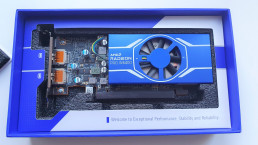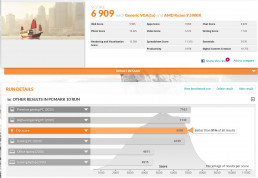On the January 19, 2022, AMD announced the new entry-level AMD Radeon PRO W6400 graphics card, for mainstream workstation users, built on the RDNA 2 graphics architecture in TSMC 6nm FinFET manufacturing process technology, with low-latency Infinity Cache memory technology acting as a bandwidth amplifier.
Specifications and Features
The AMD Radeon PRO W6400 graphics card features 4GB of dedicated GDDR6 memory in a 64-bit interface, hardware raytracing and 12 compute units, 768 stream processors and 16MB of AMD Infinity Cache. Its peak half precision (FP16) performance is 7.07 TFLOPs and peak single precision matrix (FP32) performance is 3.5 TFLOPs.
The card is well designed for small form factor workstations and PCs, with a low profile — critically taking up just a single slot width including the heatsink and fan. The card includes an adapter for compatibility with full height slots. Due to its power efficiency of 50W TGP, the Radeon PRO W6400 has no need for external power connectors and can run directly off the PCIe slot power supply.
The card has two full-size DisplayPort 1.4 connectors and is ready for two UHD HDR displays supporting Ultra-High Definition (UHD), High Dynamic Range (HDR) and Ultrawide resolutions, 10-bit colors and quad-buffer 3D Stereo.
Benchmark System
Our test system combined the AMD Ryzen 9 5900X and Radeon PRO W6400 with a 32GB DDR4 3600MHz CL14 RAM kit, a 500GB M.2 Gen4 NVMe SSD and an AMD X570 ROG Crosshair VIII Formula motherboard. This system reflects a realistic midrange build, similar to what a content creator or an engineer would assemble for a system-integrated productivity PC.
Tests and Benchmarks
PCMark 10 features a comprehensive set of tests that cover the wide variety of tasks performed in the modern workplace. The tasks tested include web browsing, videoconferencing, spreadsheet and word-processing workloads, photo and video editing, and rendering and visualization. The 6,909 score the platform achieved was better than 91% of all results, which is very convincing for office productivity use cases.
We used Barcelona Pavilion in the Blender benchmark to test the rendering performance of the professional graphics card, which took more than 12 minutes to accomplish. This result is close to that of AMD Ryzen 7 2700, which indicates that using a modern processor for image rendering is a better option. The same goes for video rendering, since the card lacks encoding acceleration and supports video acceleration and decoding of HEVC/H265 only — it does not support AOMedia Video 1 (AV1), which is used by Netflix!
Finally, but most importantly, comes the SPECviewperf 2020 v2.0 benchmark, the industry’s standard for measuring graphics performance based on professional applications with real workloads from prominent ISVs. We focused on CAD/CAM/CAE, starting with snx-04 viewset, created from traces of the graphics workload generated by the NX 8.0 application from Siemens PLM.
The Radeon PRO W6400 posted a composite score of 171.77 with 188.4 average fps, an excellent result that reflects what the card is really good for. We then tested the card performance with the solidworks-05 viewset, created from traces of Dassault Systèmes’ Solidworks 2020 application.
The composite score for this benchmark was 59.45 at an average of 94fps. However, the two NASA crawler sets in shaded mode, which are the most challenging, were running at an average of 2fps, which is not practical.
IDC Opinion and Conclusion
The Radeon PRO W6400 provided a very pleasant user experience. Since it came in SFF and we needed to install it in a compact tower, it was necessary to change the bracket, although this was easily accomplished with the changing of only four screws. The highest GPU temperature we recorded was 84c, which occurred under unrealistic stress from FurMark.
This is a good result, considering the near-silent fan operation (you cannot hear the cooling fan even at full load). The display on our Dell S3422DWG monitor at Quad HD 3440 × 1440 in 10-bit color depth, 144Hz refresh rate, with FreeSync and HDR was smooth and free of any issues.
We have mixed views regarding this card. It is heavily restricted in terms of the 4GB of 64-bit memory and has only 4 lanes of PCI express instead of the 8 or 16 commonly used on the latest generation of GPUs. While this is less of an issue when used in a PCIe 4-capable machine, many commercial workstations and PCs are based on PCIe3, which halves the effective bandwidth available and can result in performance issues with GPU workloads that demand more than the 4GB installed on the W6400.
Also telling is the lack of modern hardware-based video codec encoding and decoding acceleration. On the other hand, the Infinity Cache strongly supports the card’s performance, and you don’t feel any RAM restrictions. That said, in very complicated and very dense models with shading, which exceeds the memory’s capacity, should be addressed with higher grade of professional graphics cards anyway, like the Radeon Pro W6600.
It also fits well into the limited space in small form-factor workstations and PCs, and power consumption and noise are very low. It performs very well in entry-level CAD/CAM/CAE and general office productivity tasks. Finally, we have no complaints with AMD’s suggested price around EUR 200 — and even if it hits EUR 250 after margins and taxes, it still represents an excellent value compared to other single-slot GPU offerings of similar performance.
We believe that, despite some limitations to hit price and power targets, this card offers a solid alternative to using an integrated GPU, and that it will find its way to small form-factor OEM workstations from companies like Dell, HP Inc., and Lenovo, especially as it uses just a single slot and requires no extra power connections.
It will find a place as well in commercial PCs for professionals who are not necessarily engineers, but who would appreciate the support for dual display, tons of opened applications and browser tabs, along with office documents and video conferencing! We see that the perfect use case would be for CAD draftsmen and designers, who appreciate a quiet working environment, especially if they are sharing a dense open-plan office space.
Business owners and CFOs will also appreciate the low power consumption and savings on the energy bill. This is also a suitable GPU for light users to run applications like Solidworks for personal projects — like 3D printing at home — while avoiding the premium price tag of a higher end professional card.
Some users who rely heavily on the processor for compute tasks may find it beneficial to invest in a higher-end CPU with more cores and higher frequencies and save on graphics by using the Radeon Pro W6400, which delivers a great display.
To learn more about our upcoming research, please contact Mohamed Hefny or Andrew Buss, or head over to https://www.idc.com/eu and drop your details in the form on the top right.








